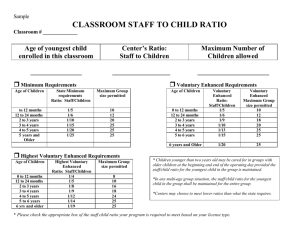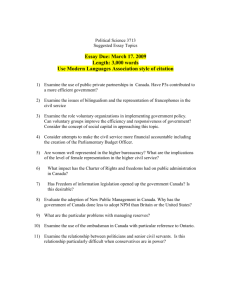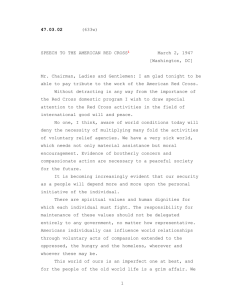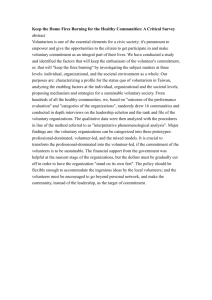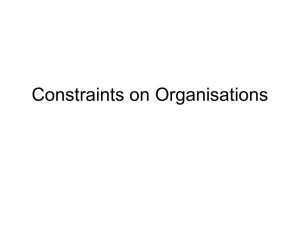The division of labor and voluntary production - iies - faces
advertisement
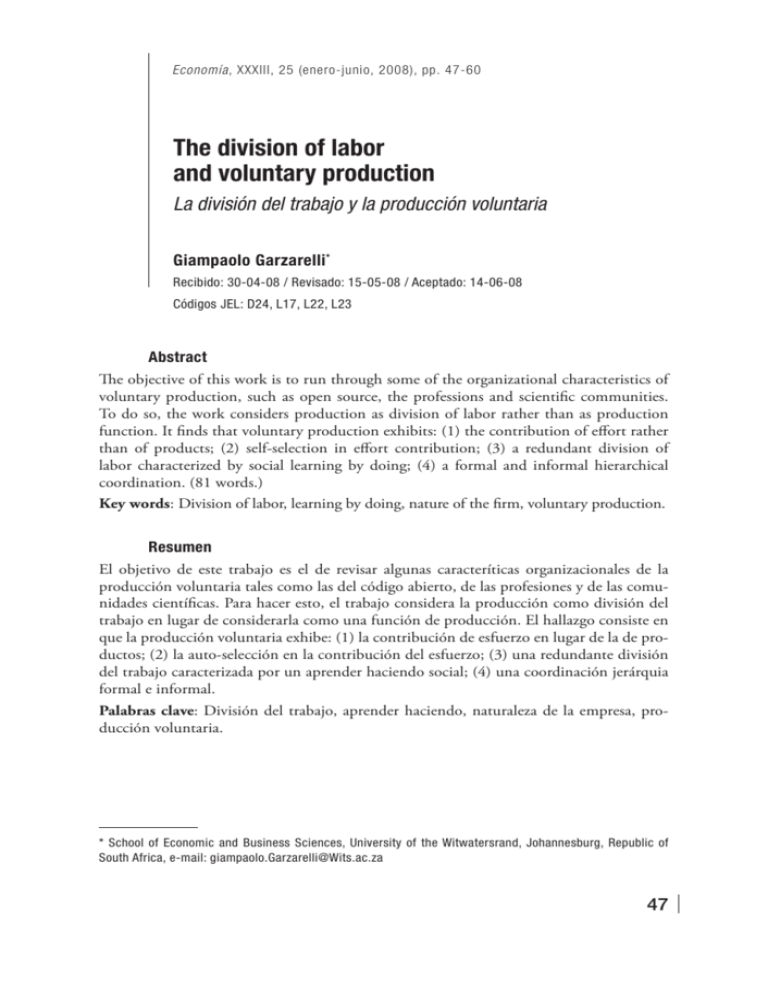
Economía, XXXIII, 25 (enero-junio, 2008), pp. 47-60 The division of labor and voluntary production La división del trabajo y la producción voluntaria Giampaolo Garzarelli* Recibido: 30-04-08 / Revisado: 15-05-08 / Aceptado: 14-06-08 Códigos JEL: D24, L17, L22, L23 Abstract The objective of this work is to run through some of the organizational characteristics of voluntary production, such as open source, the professions and scientific communities. To do so, the work considers production as division of labor rather than as production function. It finds that voluntary production exhibits: (1) the contribution of effort rather than of products; (2) self-selection in effort contribution; (3) a redundant division of labor characterized by social learning by doing; (4) a formal and informal hierarchical coordination. (81 words.) Key words: Division of labor, learning by doing, nature of the firm, voluntary production. Resumen El objetivo de este trabajo es el de revisar algunas caracteríticas organizacionales de la producción voluntaria tales como las del código abierto, de las profesiones y de las comunidades científicas. Para hacer esto, el trabajo considera la producción como división del trabajo en lugar de considerarla como una función de producción. El hallazgo consiste en que la producción voluntaria exhibe: (1) la contribución de esfuerzo en lugar de la de productos; (2) la auto-selección en la contribución del esfuerzo; (3) una redundante división del trabajo caracterizada por un aprender haciendo social; (4) una coordinación jerárquia formal e informal. Palabras clave: División del trabajo, aprender haciendo, naturaleza de la empresa, producción voluntaria. * School of Economic and Business Sciences, University of the Witwatersrand, Johannesburg, Republic of South Africa, e-mail: giampaolo.Garzarelli@Wits.ac.za 47 Economía, XXXIII, 25 (enero-junio, 2008) Giampaolo Garzarelli 1. Introduction In a very general sense, we can distinguish two archetypical stories about how economics views production. We may identify the first story with the one present in the standard economics textbook. In this story production is tantamount to a production function, viz., a certain quantity of output depends on a certain quantity of inputs. As Philip Wicksteed (1999 [1894], p. 4, emphasis removed) originally wrote, the “Product being a function of the factors of production we have P = f(a, b, c, ....).” This formulation of production is no doubt useful, think for example of the heuristic value of maximization theory. But when we need to move beyond mere quantity relationships to consider the way in which inputs are transformed into output, the production function approach loses its charms. Briefly, this first archetypical story does not shed much light on different feasible organizations of inputs, because the production function already implies a choice of organization among inputs. This entails that for the same production function there may be different organizations of production (e.g., Winter, 2005). The observation that the same production function may subsume a multitude of possible relationships among inputs is actually the motivational root of the second archetypical production story in economics. This second story in fact renders explicit what the first story keeps implicit, namely, organization. Here production is about complex division of labor dynamics that hinge not just on quantitative combinations of inputs but also on qualitative ones where, for instance, coordination, differential knowledge, factor complementarities, problem solving, and task partitioning are of the essence (e.g., Marengo and Dosi 2005). What follows is a story in the nature of the second archetype that concentrates on voluntary organization, that is, on a type of production where individuals spontaneously supply their effort (open source, scientific research, etc.). The purpose of the story is to consider some of the organizational characteristics of voluntary production. The story illustrates, in broad strokes, how voluntary production is based on a 48 Economía, XXXIII, 25 (enero-junio, 2008) The division of labor and voluntary production, pp. 47-60 type of division of labor that –for “efficiency” reasons– one would not expect to find. Our story starts with a concise discussion of the nature of voluntary organization in relation to the more familiar organizational wisdom. 2. The nature of voluntary organization When we think about the problem of economic organization what often comes to mind is Coase’s famous proposition that the nature of the firm is the economizing of the costs of using the market. Or, differently phrased, the Coasean idea is that the firm comes about when the transaction costs of using the market are higher than the corresponding ones of internal organization (Coase, 1937). This led many, implicitly or otherwise, to envision a twofold governance world. On the one hand, we have the market, where the invisible hand governs price and quantity relations directed towards no specific end; on the other, we have the firm (and other forms of internal organization), where a visible hand governs through authority a multitude of relations directed towards a specific end. Coase implies that the problem of economic organization has its solutions at polar extremes (firm or market?). Motivated by the insight that the factual governance of economic activities is about shades of gray rather than polar extremes, starting from the 1960s other scholars refined the Coasean proposition.1 One refinement germane to our purposes is that of Cheung (1983). Markets are exchange mechanisms for products or inputs. The nature of market exchange, moreover, relies on spontaneous coordination: it is relative prices rather than authority that guide resources to their most valued use. With this in mind, Cheung qualified that a firm supplants contracts for products with employment contracts, effectively replacing a factor market for a product market; at the same time, a firm manifests central design or direction rather than spontaneous coordination. Notice how Cheung’s refinement indirectly outlines two neglected alternatives: centrally directed product markets and spontaneously coordinated factor markets. If inside contracting and 49 Economía, XXXIII, 25 (enero-junio, 2008) Giampaolo Garzarelli outsourcing may be considered illustrations of centrally directed product markets, voluntary collaboration is an illustration of a spontaneously coordinated factor market.2 Figure 1 presents the two dimensions of the Coasean proposition schematically. The columns are about production self-identification issues. Is an individual working on a task because he is instructed to do so (design)? Or is an individual working on a task from self-selection (spontaneity)? The rows address matters of contribution: is an individual contributing her effort or a product? If she is contributing effort it (usually) means that she is hired, being supervised and being compensated for her time and input through a wage; if she is contributing a product, it means that her product is being bought directly. (The horizontal dimension is thus Cheung’s refinement of Coase.) Box I represents the world of inside or outside contracting where the division of labor is centrally designed, but the products of that labor are easily measured and priced. Box II is filled with the classic market: participants self-select their contributions; but measurement and pricing costs are not prohibitive, and those contributions take the form of products offered on spec. Box III contains the classic firm, where the division of labor remains centrally designed, but the cost of measuring and pricing transactions makes it cheaper to purchase the effort of collaborators directly. (Now notice how Coase’s original proposition is only boxes II and III.) In box IV participants selfselect their contributions; but those contributions come directly in the form of effort rather than of effort embodied in a product. That is, we do not have, for instance, a spot market in day labor where day laborers don’t choose what they work on; rather, we have a division of labor where individuals do sometimes produce specific products in the end, but in the context of spontaneously adding effort to a larger product not making a product on spec. Box IV is the model of voluntary production (Langlois and Garzarelli, 2008). Arguably, the illustration of voluntary production that is currently gaining the most scientific attention –and that we mostly refer to here– is that of open source software, a collaborative software production mode that is founded on code sharing and open standards (e.g., Raymond, 2001). But voluntary production has other (and older) manifestations, 50 Economía, XXXIII, 25 (enero-junio, 2008) aȱdivisionȱofȱlaborȱwhereȱindividualsȱdoȱsometimesȱproduceȱspecificȱproductsȱ inȱtheȱend,ȱbutȱinȱtheȱcontextȱofȱspontaneouslyȱaddingȱeffortȱtoȱaȱlargerȱproductȱ The division of labor and voluntary production, pp. 47-60 notȱ makingȱ aȱ productȱ onȱ spec.ȱ Boxȱ IVȱ isȱ theȱ modelȱ ofȱ voluntaryȱ productionȱ (LangloisȱandȱGarzarelliȱ2008).ȱ such as the organization of scientific communities (e.g., David 1998) and of the professions (doctors, lawyers, etc.) (e.g., von Hippel 1987). Figureȱ1:ȱCoaseȱ(1937)ȱinȱTwoȱDimensionsȱ ȱ Arguably,ȱ theȱ illustrationȱ ofȱ voluntaryȱ productionȱ thatȱ isȱ currentlyȱ Design:ȱ Spontaneity:ȱ ȱ Individualsȱdon’tȱȱ Individualsȱȱ gainingȱtheȱmostȱscientificȱattentionȱ–ȱandȱthatȱweȱmostlyȱreferȱtoȱhereȱ–ȱisȱthatȱ selfȬidentifyȱ selfȬidentifyȱ Iȱ IIȱ ofȱ openȱ sourceȱ software,ȱ aȱ collaborativeȱ softwareȱ productionȱ modeȱ thatȱ isȱ Individualsȱ ȱ ȱ Insideȱcontractingȱȱ Classicȱmarketȱȱ contributeȱ foundedȱ onȱ codeȱ sharingȱ andȱ openȱ standardsȱàȱlaȱPrinciplesȱofȱ (e.g.,ȱ Raymondȱ 2001).ȱ Butȱ productsȱ Outsourcingȱ Economicsȱ voluntaryȱ productionȱ hasȱ otherȱ (andȱ older)ȱ manifestations,ȱ suchȱ asȱ theȱ IIIȱ IVȱ Individualsȱ ȱ ȱ organizationȱofȱscientificȱcommunitiesȱ(e.g.,ȱDavidȱ1998)ȱandȱofȱtheȱprofessionsȱ Classicȱfirmȱȱ Voluntaryȱproductionȱȱ contributeȱȱ àȱlaȱCoaseȱ (e.g.,ȱopenȬsourceȱsoftware,ȱ effortȱ (doctors,ȱlawyers,ȱetc.)ȱ(e.g.,ȱvonȱHippelȱ1987).ȱ science,ȱtheȱprofessions)ȱ Source:ȱAfterȱLangloisȱandȱGarzarelliȱ(2008,ȱp.ȱ137).ȱ Figure 1. Coase (1937) in Two Dimensions. Source: After Langlois and Garzarelli (2008, p. 137) ȱ 3ȱ DivisionsȱofȱLaborȱ Inȱ hisȱ analysisȱ aboutȱ theȱ originsȱ ofȱ economicȱ growth,ȱ Smithȱ (1981[1776])ȱ 3. Divisions of labor 3 5ȱ alludedȱtoȱtwoȱformsȱofȱdivisionȱofȱlaborȱ–ȱverticalȱandȱhorizontal. In his analysis about the origins of economic growth, Smith (1981 [1776]) alluded to two forms of division of labor –vertical and horizontal3. Figureȱ2:ȱVerticalȱDivisionȱofȱLaborȱ A1ȱ ȱ A2ȱ ȱ A3ȱ ȱ B2ȱ ȱ B3ȱ ȱ ȱ A4ȱ ȱ B4ȱ ȱ A5ȱ B5ȱȰȱIndividualȱBȱworkingȱonȱȱ ȱ theȱentireȱproductionȱsequenceȱ B1ȱ ȱ C1ȱ C2ȱ ȱ C3ȱ C4ȱ ȱ C5ȱ D1ȱ D2ȱ D3ȱ D4ȱ ȱ D5ȱ ȱ E1ȱ E2ȱ E3ȱ E4ȱ E5ȱ Timeȱ Figure 2. Vertical division of labor. Source: Leijonhufvud (1986, p. 208). Source:ȱLeijonhufvudȱ(1986,ȱp.ȱ208).ȱ ȱ 51 Thinkȱofȱfiveȱindividuals,ȱA,ȱB,ȱC,ȱD,ȱE,ȱandȱfiveȱproductionȱtasks,ȱ1,ȱ2,ȱ3,ȱ Economía, XXXIII, 25 (enero-junio, 2008) 4,ȱ 5.ȱ Ifȱ theȱ divisionȱ ofȱ laborȱ isȱ suchȱ thatȱ eachȱ ofȱ theȱ fiveȱ individualsȱ performsȱ Giampaolo Garzarelli Think of five individuals, A, B, C, D, E, and five production tasks, 1, 2, 3, 4, 5. If the division of labor is such that each of the five individuals performs each of the five tasks sequentially (A1, A2, A3 …) we face a situation of vertical division of labor. This is a situation typical of artisanal production, where the artisan performs every single production task, often times right down to the selling. See Figure 2. When the eachȱofȱtheȱfiveȱtasksȱsequentiallyȱ(A1,ȱA2,ȱA3,ȱ…)ȱweȱfaceȱaȱsituationȱofȱverticalȱ market grows to such an extent that it allows each individual to perform only one task, the result is horizontal division of labor. In this case, divisionȱofȱlabor.ȱThisȱisȱaȱsituationȱtypicalȱofȱartisanalȱproduction,ȱwhereȱtheȱ each production task (our 1, 2, 3, 4, 5) becomes a trade in its own. So, in terms everyȱ of oursingleȱ notation, we would now have individual A doing only artisanȱ performsȱ productionȱ task,ȱ oftenȱ timesȱ rightȱ downȱ toȱ theȱ task 1, individual B doing only task 2, individual C doing only task 3, etc. Figureȱ The individuals become complementary. processthatȱ is depicted selling.ȱ Seeȱ 2.ȱ Whenȱ theȱ marketȱ growsȱ toȱ suchȱThis anȱ extentȱ itȱ allowsȱby Figure 3. Intoȱ theperformȱ case of vertical division of labor that each individual eachȱ individualȱ onlyȱ oneȱ task,ȱ theȱ resultȱwe isȱhave horizontalȱ divisionȱ ofȱ is competent, if to different degrees, in a variety of production tasks, entailing that there is little specialization at work. What is at work, labor.ȱInȱthisȱcase,ȱeachȱproductionȱtaskȱ(ourȱ1,ȱ2,ȱ3,ȱ4,ȱ5)ȱbecomesȱaȱtradeȱinȱitsȱ rather, are both absolute and comparative advantages across the production sequence. But each individual production task, we pointed own.ȱSo,ȱinȱtermsȱofȱourȱnotation,ȱweȱwouldȱnowȱhaveȱindividualȱAȱdoingȱonlyȱ out, can become a trade of its own. As a result, in horizontal division of labor there is mostly comparative advantage at work. The benefits taskȱ1,ȱindividualȱBȱdoingȱonlyȱtaskȱ2,ȱindividualȱCȱdoingȱonlyȱtaskȱ3,ȱetc.ȱTheȱ of comparative advantage can be captured by one notion: increasing returns. Increasing returns have the well-known property that an increase individualsȱbecomeȱcomplementary.ȱThisȱprocessȱisȱdepictedȱbyȱFigureȱ3.ȱ in input results in a more than proportional increase in output. Thanks Figureȱ3:ȱHorizontalȱDivisionȱofȱLaborȱ A1ȱ ȱ ȱ ȱ ȱ ȱ ȱ ȱ ȱ ȱ ȱ ȱ B2ȱ ȱ A1ȱ ȱ ȱ ȱ ȱ ȱ ȱ ȱ ȱ ȱ C3ȱ ȱ B2ȱ ȱ A1ȱ ȱ ȱ ȱ ȱ ȱ ȱ ȱ D4ȱ ȱ C3ȱ ȱ B2ȱ ȱ A1ȱ ȱ ȱ ȱ ȱ ȱ E5ȱ D4ȱ ȱ C3ȱ ȱ B2ȱ ȱ A1ȱ ȱ ȱ ȱ E5ȱ D4ȱ ȱ C3ȱ ȱ B2ȱ ȱ Etc.ȱȱ E5ȱ D4ȱ ȱ E5ȱ C3ȱ ȱ D4ȱ ȱ ȱ …ȱȱ E5ȱ Timeȱ Figure 3. HorizontalSource:ȱLeijonhufvudȱ(1986,ȱp.ȱ209).ȱ division of labor. Source: Leijonhufvud (1986, p. 209). ȱ Inȱ52 theȱ caseȱ ofȱ verticalȱ divisionȱ ofȱ laborȱ weȱ haveȱ thatȱ eachȱ individualȱ isȱ Economía, XXXIII, 25 (enero-junio, 2008) competent,ȱ ifȱ toȱ differentȱ degrees,ȱ inȱ aȱ varietyȱ ofȱ productionȱ tasks,ȱ entailingȱ The division of labor and voluntary production, pp. 47-60 to comparative advantage, the horizontal division of labor is arguably an improvement over the vertical. It is, moreover, a good approximation of the organization of the factory, and hence also at the foundation of the more “evolved” organization of the joint stock corporation (Leijonhufvud 1986). It is thus natural to think that most “efficient” contemporary forms of organization would also manifest an internal organization that minimizes vertical characteristics, favoring the horizontal. However, there is one contemporary organizational manifestation that does not fully accord with such traditional “efficiency” argument: voluntary production.4 4. Voluntary division of labor In a traditional firm, individuals are hired on the basis of their implied specialization. A is hired because he is an in expert human resources (task 1), B because he is an accountant (task 2), C because he is an expert in marketing (task 3), D because she is a financial analyst, etc. The organization of work is hierarchical and relies on a substantial degree of planning so that everyone is aware not only of the general organizational goal but also of his or her specific goal(s) before any task is begun. When viewed in these basic terms, we can think of Figure 3 as a heuristic expedient capturing the rudimentary essence of a firm’s division of labor as well: a (designed) division of labor according to expertise in the attempt to simplify a set of complex tasks into smaller sets of less complex tasks in order to achieve a well-defined objective. Voluntary production instead assumes that there should be little conscious planning: it believes that it is impossible to identify –and hence to hire– a set of individuals having the complete knowledge to efficiently solve all possible problems in every point in time. Being based on the assumption of human fallibility due to cognitive limitations (e.g., Jensen and Meckling 1992), the premise is to keep all input options open by not trying to hire the best input ex ante, but by letting individuals selfselect their input as situations demand. Tasks are literally taken up by interested individuals as they emerge. In this way, voluntary production is 53 Economía, XXXIII, 25 (enero-junio, 2008) Giampaolo Garzarelli able to rely on a large –in effect, potentially unlimited– knowledge pool. As Eric Raymond, hacker and author of the very influential open source “manifesto” The Cathedral and the Bazaar, writes about the voluntary production of source code: while “coding remains an essentially solitary ownȱbrainȱinȱaȱclosedȱprojectȱisȱgoingȱtoȱfallȱbehindȱtheȱdeveloperȱwhoȱknowsȱ activity, the really great hacks come from harnessing the attention and brainpower of entire communities. The developer who uses only his or howȱ toȱ createȱ anȱ open,ȱ evolutionaryȱ contextȱ inȱ whichȱ feedbackȱ exploringȱ theȱ her own brain in a closed project is going to fall behind the developer designȱspace,ȱcodeȱcontributions,ȱbugȬspotting,ȱandȱotherȱimprovementsȱcomeȱ who knows how to create an open, evolutionary context in which feedback exploring the design space, code contributions, bug-spotting, fromȱhundredsȱ(perhapsȱthousands)ȱofȱpeople”ȱ(Raymondȱ2001,ȱpp.ȱ50Ȭ1).ȱ and other improvements come from hundreds (perhaps thousands) of people” (Raymond, 2001, pp. 50-1). Figureȱ4:ȱVoluntaryȱDivisionȱofȱLaborȱ ȱ A1ȱ B1ȱ C1ȱ D1ȱ ȱ ȱ F1ȱ ȱ ȱ ȱ ȱ ȱ ȱ ȱ ȱ ȱ ȱ ȱ ȱ ȱ ȱ ȱ ȱ O1ȱ ȱ ȱ ȱ ȱ ȱ ȱ ȱ ȱ .ȱ ȱ .ȱ ȱ .ȱ ȱ …ȱ ȱ ȱ ȱ ȱ ȱ ȱ ȱ ȱ …ȱ A2ȱ ȱ C3ȱȰȱIndividualȱCȱworkingȱonȱmultipleȱinputsȱ ȱ F2ȱ G2ȱ H2ȱ I2ȱ ȱ ȱ ȱ ȱ ȱ ȱ ȱ Q2ȱ ȱ ȱ ȱ ȱ ȱ ȱ .ȱ .ȱ .ȱ ȱ E3ȱ ȱ G3ȱ ȱ F4ȱ J3ȱ K3ȱ ȱ L3ȱ M3ȱ ȱ N4ȱ ȱ O4ȱ ȱ P4ȱ ȱ Q4ȱ ȱ ȱ ȱ ȱ .ȱ ȱ .ȱ ȱ .ȱ ȱ …ȱ ȱ ȱ .ȱ ȱ .ȱ ȱ .ȱ ȱ ȱ Etc.ȱ E5ȱ K5ȱ O5ȱ R5ȱ S5ȱ ȱ ȱ ȱ ȱ ȱ ȱ ȱ …ȱ .ȱ .ȱ .ȱ …ȱȱ ȱ ȱ ȱ ȱ ȱ .ȱ .ȱ .ȱ ȱ ȱ …ȱ Parallel,ȱoverlappingȱinputsȱ Figure 4. Voluntary division of labor Source: After Garzarelli, Limam and Thomassen (2008, p. 128). Source:ȱAfterȱGarzarelli,ȱLimamȱandȱThomassenȱ(2008,ȱp.ȱ128).ȱ 54 Economía, XXXIII, 25 (enero-junio, 2008) 10ȱ The division of labor and voluntary production, pp. 47-60 And yet, to tap from effort in a spontaneous fashion does not necessarily imply a horizontal division of labor in the traditional sense. As Raymond points out, there may be a great number of individuals each working in parallel on the same task. But the fact that several individuals may be working on multiple tasks at once also more generally means that voluntary organization can simultaneously present both vertical and horizontal division of labor characteristics, implying that there is some redundancy at play. However, the redundancy is not a shortcoming: it engenders economies that have the ability to capitalize on multiple, intersecting knowledge combinatorics. The parallel, overlapping inputs encourage a production mode whereby being specialized in a particular task is not a condicio sine qua non to contribute: a contributor’s input may not always directly reflect his primary specialty. What matters is the spontaneity of the contribution, because the shared belief is that there’s potentially something to learn from everyone (Garzarelli, Limam and Thomassen, 2008). The redundancy innate in voluntary production therefore allows for learning by doing. But, in contrast to the horizontal division of labor where the learning by doing mostly takes place individually through repetition of the same task, in voluntary production the learning by doing is social. It is social in the sense that, because of the redundancy, individuals may learn from others who are also working on the same task. To continue with Leijonhufvud’s shorthand, voluntary production presents cases like A1, B1, C1, D1, F1, O1; A2, F2, G2, H2, I2, Q2; C3, E3, G3, J3, K3, L3, M3; etc. Figure 4 illustrates a possible voluntary division of labor, which, e.g., can be considered a good approximation of a large open source project such as Debian.5 At the same time, I am not suggesting that, because of spontaneous contributions, voluntary production presents no hierarchy or authority. As a voluntary project grows, so does the possibility that individuals lose track of priorities. For instance, in projects such as Debian package maintainers usually have complete authority over their part of the project. But because they are volunteers, it is not uncommon for them to lose interest or become busy with something else that is not, e.g., a top priority. If package maintainers stop maintaining their package the 55 Economía, XXXIII, 25 (enero-junio, 2008) Giampaolo Garzarelli quality of the overall project may suffer over time. In economic lingo, this is one possible nonroutine pattern of behavior that could also lead to lock-in in David’s (1985) well-known sense. And it is above all in these cases that in voluntary production the hierarchy more typical of the firm manifests itself (cf. Langlois and Garzarelli, 2008). In open source projects, for example, the project leader intervenes. An open source project leader is at the top of the organizational hierarchy, and his role is usually formally established by the statute (or constitution) of the organization. Traditionally, a leader has authority to grant some rights to developers and is expected to intervene in times of “urgent action.” Holding everything else constant, think, for instance, about a scenario where the redundancy of voluntary organization begins to tip in favor of substitute inputs rather than complementary ones. In such a case, intervention may be called for. Be that as it may, it would seem that in actual fact the most fundamental role that a project leader plays is one that has mostly to do with coordinating rather than directing production.6 “The Debian leadership,” for instance, “checks to ensure that each package is assembled correctly and that system as a whole is solid; the end result is a set of packages that, though developed and maintained by many different individuals, are as consistent and as professionally constructed as if they were developed by a single person or closely-knit group, but without the limitations imposed by centralized development” (Murdock, 1994). To this Raymond (2001, p. 59, original emphasis) adds: “the poor beleaguered conventional manager is not going to get any [succour] from the monitoring issue; the strongest argument the open source community has is that decentralized peer review trumps all the conventional methods for trying to ensure that details don’t get slipped.” In voluntary production, however, it is also possible for a less visible or formal authority to intervene. For example, a key contributor in a particular area of an open source project may be considered a “master” of a particular problem, even if he or she has no formal “title” in the organization.7 In more explicit economics-of-organization terms, this 56 Economía, XXXIII, 25 (enero-junio, 2008) The division of labor and voluntary production, pp. 47-60 means that in voluntary organization hierarchy does not just derive from design (i.e., the rules of the organizational statute), but from charisma as well (Weber 1964 [1947], pp. 358ff.; Coleman 1990). The hierarchy from charismatic authority mostly derives from the reputation earned by coordinating a successful voluntary project. Another illustration is easily found in academia. It is not uncommon to find a department head who may carry the “same weight” of a faculty member whose research reputation is in high regard. Though its origin rests more with reputation than with design, in voluntary production charismatic authority can be seen as another way (i.e., alongside traditional leadership) to solve possible “inefficiencies” tied to self-selection (e.g., working on an issue that is of secondary importance). 5. Conclusion The present work looks, in a very idiosyncratic and partial way, at the nature and division of labor dynamics of voluntary organization. It finds that the distinguishing marks of voluntary production are: – – – – the contribution of effort rather than of products; self-identification or spontaneity rather than direction when it comes to the contribution of effort; a redundant division of labor whereby in any point in time more than one individual may be working spontaneously on the same task, which entails the benefit of social learning by doing; the presence of formal and informal hierarchy the role of which is more to coordinate than to monitor production. This is not necessarily to say that these distinguishing marks are only typical of voluntary production, but that voluntary production typically manifests these marks. Moreover, this does not mean that there are only four distinguishing marks of voluntary production. For example, modularity has been left in the background. 57 Economía, XXXIII, 25 (enero-junio, 2008) Giampaolo Garzarelli 6. Notes 1 2 3 4 5 6 7 Thanks mostly to the overnight success of Coase (1960) there was an immediate interest in Coasean ideas more generally, and hence also a re-consideration of Coase (1937). For the different economics-oforganization traditions that over the years Coase (1937) and Coase (1960) led to, see Foss (1994). One of the first allusions to voluntary production in economics-oforganization terms is in the preliminary typescript by Garzarelli and Galoppini (2003). This section draws on Garzarelli, Limam and Thomassen (2008, especially pp. 123-5). I do not mean to suggest that all contemporary production processes are heirs of the factory system; nor do I mean to say that the organization of work of the archetypical firm cannot combine vertical and horizontal divisions of labor (and more…[cf. Morroni, e.g., 1999]). I simply mean to suggest that, at least since the industrial revolution, the horizontal division of labor is typically the basis of non-agricultural forms of production. However, there are exceptions in agriculture too. See in particular Georgescu-Roegen (e.g., 1976 [1965]). Debian is an association of volunteers who work on an operating system called Debian GNU/Linux. GNU is a recursive acronym that stands for “GNU’s Not UNIX”; it is pronounced “guh-NEW” (http://www.gnu. org/). Linux refers to the kernel –the central functions– of the operating system; GNU/Linux is the complete operating system, including the Linux kernel along with other software components. A distribution is simply a (usually complete) packaging of the Linux kernel with other software needed to complete the operating system. Debian GNU/Linux is a GNU/Linux distribution that is produced entirely by volunteers. See, e.g., http://www.debian.org/devel/leader.en.html Bdale Garbee, former Debian Project Leader, personal communication (25 July, 2003). 58 Economía, XXXIII, 25 (enero-junio, 2008) The division of labor and voluntary production, pp. 47-60 7. References Cheung, Steven N. S. (1983). “The Contractual Nature of the Firm.” Journal of Law and Economics 26, 1 (April), pp. 1-21. Coase, Ronald H. (1937). “The Nature of the Firm.” Economica (N.S.) 4, 16 (November), pp. 386-405. Coase, Ronald H. (1960). “The Problem of Social Cost.” Journal of Law and Economics 3, 1 (October), 1-44. Coleman, James S. (1990). “Rational Organization.” Rationality and Society 2, 1 (January), pp. 94-105. David, Paul A. (1985). “Clio and the Economics of qwerty.” American Economic Review, Papers and Proceedings 75, 2 (May), pp. 332-337. David, Paul A. (1998). “Common Agency Contracting and the Emergence of ‘Open Science’ Institutions.” American Economic Review, Papers and Proceedings 88, 2 (May), pp. 15-21. Foss, Nicolai J. (1994). “The Two Coasian Traditions.” Review of Political Economy 6, 1 (January), pp. 37-61. Garzarelli, Giampaolo and Roberto Galoppini (2003). “Capability Coordination in Modular Organization: Voluntary FS/OSS Production and the Case of Debian GNU/Linux.” Industrial Organization 0312005, EconWPA, http://ideas.repec.org/p/wpa/wuwpio/0312005.html Garzarelli, Giampaolo, Yasmina R. Limam, and Bjørn Thomassen (2008). “Open Source Software and Economic Growth: A Classical Division of Labor Perspective.” Information Technology for Development 14, 2 (Spring), pp. 116-135. Georgescu-Roegen, Nicholas (1976). “Process in Farming versus Process in Manufacturing: A Problem of Balanced Development,” in Idem (ed.), Energy and Economic Myths: Institutional and Analytical Economic Essays. New York: Pergamon Press Inc. Originally published in 1965 as Ch. 24 of Economic Problems of Agriculture in Industrial Societies, Proceedings of a Conference of the International Economic Association, Rome, September. Jensen, Michael C., and William H. Meckling. (1992). “Specific and General Knowledge, and Organizational Structure,” in W. Lars and H. Wijkander (eds.), Contract Economics. Oxford: Basil Blackwell, pp. 251-74. 59 Economía, XXXIII, 25 (enero-junio, 2008) Giampaolo Garzarelli Langlois, Richard N., and Giampaolo Garzarelli (2008). “Of Hackers and Hairdressers: Modularity and the Organizational Economics of Opensource Collaboration.” Industry and Innovation 15, 2 (April), pp. 125143. Leijonhufvud, Axel (1986). “Capitalism and the Factory System,” in R. N. Langlois (ed.), Economics as a Process: Essays in the New Institutional Economics. New York: Cambridge University Press, pp. 203-223. Marengo, Luigi and Giovanni Dosi (2005). “Division of Labor, Organizational Coordination and Market Mechanisms in Collective Problem-solving.” Journal of Economic Behavior and Organization 58, 2 (October), pp. 303-326. Morroni, Mario (1999). “Production and Time,” in K. Mayumi and J. M. Gowdy (eds), Bioeconomics and Sustainability: Essays in Honor of Nicholas Georgescu-Roegen. Cheltenham, UK: Edward Elgar, pp. 194-228. Murdock, Ian (1994). “The Open Development of Debian.” Linux Journal 3es: Article No. 7 (June-July). Raymond, Eric S. (2001). The Cathedral and the Bazaar. Musings on Linux and Open Source by an Accidental Revolutionary (revised edition). Sebastopol, CA: O’Reilly & Associates, Inc. Smith, Adam (1981). An Inquiry into the Nature and Causes of the Wealth of Nations (two volumes). Indianapolis: Liberty Fund. First published 1776. von Hippel, Eric (1987). “Cooperation Between Rivals: Informal Know-how Trading.” Research Policy 16, 6 (December), pp. 291-302. Weber, Max (1964). The Theory of Social and Economic Organization. Translated by A. M. Henderson and Talcott Parsons. Edited with an “Introduction” by Talcott Parsons. New York: The Free Press. Originally published 1947. Wicksteed, Philip H. (1999). An Essay on the Co-ordination of the Laws of Distribution. London: London School of Economics (Reprint No. 12 in the Series of Reprints of Scarce Tracts in Economic and Political Science). First published in 1894; 1932 edition; 1999 electronic edition available at http://cepa.newschool.edu/het/texts/wicksteed/wickess.pdf Winter, Sidney G. (2005). “Toward an Evolutionary Theory of Production,” in K. Dopfer (ed.), The Evolutionary Foundations of Economics. Cambridge: Cambridge University Press, pp. 223-254. 60 Economía, XXXIII, 25 (enero-junio, 2008)


